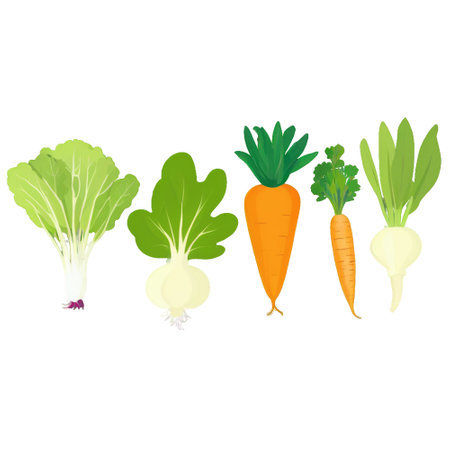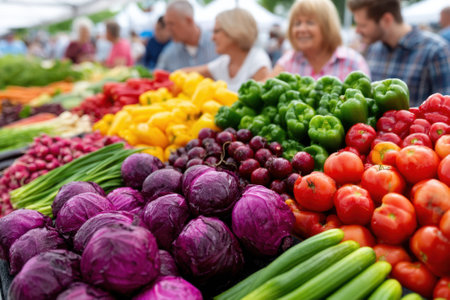Embracing the Rhythm of the Seasons
In our fast-paced, convenience-driven culture, its easy to forget that our food once followed a natural rhythm—a dance guided by the passing of each season. Embracing seasonal plant-based eating is more than just a dietary trend; it’s an intentional choice to reconnect with the land and community around us. When we align our eating habits with the cycles of nature, we invite a sense of mindfulness into our kitchens and daily lives. By choosing what’s grown locally and organically during its peak, we not only support local farmers but also honor the changing landscape and flavors unique to every season. This approach deepens our connection to the environment and gently encourages us to slow down, appreciate variety, and savor what each time of year has to offer. Eating with the seasons helps us become active participants in our ecosystem rather than passive consumers, creating a lifestyle rooted in awareness and gratitude.
2. Why Local and Organic Matter
Choosing local and organic produce isn’t just a trendy lifestyle choice—it’s a meaningful way to make every meal count for both your health and the planet. When you opt for locally grown, organic fruits and vegetables, you’re doing more than filling your plate with vibrant flavors; you’re actively reducing your carbon footprint and supporting the backbone of America’s food system: small farmers. Let’s break down why these choices matter so much in our daily lives.
Reducing Your Carbon Footprint
Most conventional produce travels thousands of miles from farm to table, burning fossil fuels and generating greenhouse gases along the way. By eating what’s grown nearby, you cut out much of that transportation pollution. Plus, organic farming practices often use less energy overall, as they avoid synthetic fertilizers and pesticides.
Impact Comparison: Local vs. Conventional Produce
| Local & Organic | Conventional (Often Imported) | |
|---|---|---|
| Average Food Miles | < 250 miles | > 1,500 miles |
| Pesticide Use | Minimal/None | Common |
| Support for Local Economy | Strong | Weak |
Supporting Small Farmers & Communities
Buying from local farmers’ markets or subscribing to a community-supported agriculture (CSA) box is an investment in your neighbors. These small-scale growers are more likely to use sustainable methods, care deeply about their land, and reinvest profits in the community. Every dollar spent locally helps keep family farms thriving and preserves America’s agricultural heritage.
The Freshness Factor
Nothing beats biting into produce picked at its peak—something only local harvests can guarantee. Fresher food means more nutrients, better texture, and flavors that actually sing. Plus, seasonal options inspire creativity in the kitchen as you adapt your meals to what’s available right now.
Every Bite Counts
By choosing local and organic, you’re not just eating—you’re joining a movement that prioritizes environmental responsibility, community resilience, and personal well-being. Next time you shop, think about the story behind your food and how each decision shapes a healthier world.

3. The Art and Joy of Farmers’ Markets
There’s something uniquely American about the Saturday morning ritual of visiting a bustling farmers’ market. Rows of colorful stalls overflow with just-picked heirloom tomatoes, fragrant basil, crisp apples, and baskets of rainbow chard. The experience is more than shopping—it’s a celebration of local abundance and an invitation to eat with the seasons. As you stroll through, you hear snippets of neighbors chatting, vendors sharing recipes, and kids sampling fresh berries for the first time. This vibrant atmosphere transforms buying groceries into a meaningful connection with your community and land.
Discovering Seasonal Variety
Farmers’ markets are a gateway to seasonal plant-based eating. Unlike supermarkets stocked year-round with imported produce, these markets showcase what’s truly in season—whether it’s sweet corn in July or butternut squash in October. By choosing what’s grown locally and organically, you not only support small-scale farmers but also discover new varieties and flavors that inspire creativity in the kitchen. Each visit becomes an opportunity for a natural experiment: What can you make this week with kohlrabi, golden beets, or wild mushrooms?
Building Community Through Food
The market fosters genuine relationships. You’ll learn from growers who share stories about their crops and offer tips on how to prepare them. This knowledge grounds your meals in a sense of place and tradition. Many American towns treat their farmers’ market as a weekly gathering spot—a place where food brings people together across generations and backgrounds. It’s common to see pop-up cooking demonstrations or local musicians playing folk tunes under the shade of oak trees.
Inspiration for Plant-Based Meals
Perhaps the most joyful part is the inspiration you carry home. After seeing vibrant displays of fresh greens or tasting just-harvested peaches, you’re motivated to try new plant-based recipes that highlight seasonal flavors. Whether it’s a simple summer salad tossed with herbs or a hearty winter stew loaded with root vegetables, each meal becomes an act of reflection on the rhythms of nature—and on your own evolving tastes and traditions.
4. Seasonal Stars: A Guide to Standout Produce
One of the joys of seasonal plant-based eating is discovering which fruits and vegetables shine during different times of the year. Shopping at local farmers markets or subscribing to a community-supported agriculture (CSA) box allows you to experience what’s freshest and most flavorful in your region. Here’s a quick guide to popular produce by season, along with practical tips for choosing, storing, and enjoying them.
| Season | Regional Favorites | Selection Tips | Storage Advice | Easy Recipe Idea |
|---|---|---|---|---|
| Spring | Asparagus, strawberries, peas, radishes | Look for vibrant colors and firm textures; avoid limp or bruised items. | Store asparagus upright in water, berries in a single layer in the fridge. | Toss sliced radishes and peas into a fresh salad with lemon vinaigrette. |
| Summer | Tomatoes, sweet corn, zucchini, peaches, blueberries | Select fragrant peaches, plump tomatoes, and bright corn kernels. | Zucchini and tomatoes keep well at room temp; refrigerate berries immediately. | Grill sweet corn or make a quick peach-blueberry compote for breakfast. |
| Fall | Pumpkins, apples, Brussels sprouts, kale, pears | Choose heavy pumpkins with intact stems and crisp apples without blemishes. | Store apples in the crisper drawer; kale stays fresh wrapped in damp paper towels. | Roast Brussels sprouts with olive oil or bake an easy apple crisp. |
| Winter | Citrus fruits, root vegetables (carrots, beets), winter squash, cabbage | Pick firm squash and deeply colored citrus; avoid soft spots on roots. | Citrus lasts longer in the fridge; keep root veggies in a cool dark place. | Try a simple roasted root vegetable medley or fresh-squeezed orange juice. |
Shopping Smart at Local Markets
If you’re new to seasonal shopping, ask farmers about their favorite varieties or how they like to prepare certain crops. Many markets offer taste samples—don’t be shy! Being open to trying less familiar produce can turn grocery shopping into a mini adventure.
Savoring the Season at Home
You don’t have to be a chef to enjoy seasonal produce. A sprinkle of sea salt on ripe tomatoes or a handful of berries over oatmeal can make everyday meals feel special. The key is keeping things simple and letting the natural flavors speak for themselves.
Nurture Your Connection with Nature’s Rhythms
Tuning into each season’s bounty not only supports your health but also connects you with your local environment. Next time you’re at the market, pause to notice what’s new—and let curiosity guide your next meal.
5. Sustainable Living Through Your Plate
When we talk about sustainability, it’s easy to think of big gestures—solar panels, electric cars, or zero-waste homes. But sometimes, the most impactful changes start right on our plates. Choosing seasonal, plant-based foods sourced from local and organic farms is a simple act that ripples outwards, touching not just our health but the entire ecosystem.
Reducing Food Waste
Eating seasonally means enjoying produce when it’s at its freshest and most abundant. In American farmers markets from coast to coast, you’ll notice how tomatoes burst onto the scene in July and disappear by fall. By embracing this rhythm, we’re more likely to use what’s available instead of letting imported, out-of-season produce rot in the fridge. Less waste in our kitchens means less pressure on landfills—a small step with a surprisingly large environmental payoff.
Supporting Biodiversity
Every time we choose a variety of fruits and veggies grown locally and organically, we help keep heirloom and native plant species alive. Think about those quirky striped squash or purple carrots you spot at your neighborhood co-op: these aren’t just Instagram-worthy finds—they’re part of preserving America’s agricultural heritage. This diversity matters because it makes our food system more resilient against pests, diseases, and climate change.
Fostering a More Sustainable Future
The ripple effects don’t stop at the farm or market stand. When we prioritize local growers who use organic practices, we’re voting for soil health, cleaner waterways, and fewer pesticides in our communities. Our everyday food choices—especially when rooted in seasonal plant-based eating—become powerful tools for building a healthier planet. Over time, these habits add up to a future where sustainable living isn’t just an ideal; it’s something we practice every day, bite by bite.
6. Practical Tips for Getting Started
Making seasonal plant-based eating a seamless part of your daily routine doesn’t have to be overwhelming. Start small and embrace the process as an ongoing experiment in both health and taste. Here are some practical, family-friendly ways to get started, drawing on the power of local and organic produce.
Start with Simple Meal Planning
Each week, check what’s in season in your region—many farmers’ markets post lists online or display what’s freshest at their stands. Plan two or three dinners around these ingredients. For example, if it’s summer, think zucchini tacos or grilled corn salad. Keep a list of easy “go-to” recipes that can flex based on what’s available—stir-fries, grain bowls, and veggie-packed soups are great places to start.
Discover Local Food Resources
Support your community by shopping at local farmers’ markets, joining a CSA (Community Supported Agriculture), or seeking out farm stands. Many American cities now also offer online directories for local food sources. Don’t overlook your own backyard: even a small container garden can yield fresh herbs or greens to add seasonal flair to meals.
Get the Whole Family Involved
Turn seasonal eating into a fun family activity by letting kids help pick out colorful veggies at the market or wash produce at home. Challenge everyone to try one new fruit or vegetable each week and rate it together. You might be surprised by new favorites! For busy weeknights, prep ingredients in advance—wash greens, chop veggies, and pre-cook grains—so healthy meals come together quickly.
Embrace Flexibility and Experimentation
Nobody’s perfect when starting something new. Treat each meal as a mini-experiment: what works, what doesn’t? Celebrate successes and laugh off less-than-perfect attempts. Over time, you’ll develop a deeper connection with your food, your local community, and even the changing rhythms of nature itself—all while nourishing yourself and those you love.


